Gigabyte GA-EP45-UD3P - P45 at its Finest
by Gary Key on February 3, 2009 12:15 AM EST- Posted in
- Motherboards
SATA Performance
PCMark Vantage is the latest benchmark available from Futuremark, and it is only for use with Windows Vista. Similar to the venerable PCMark05 in its makeup, Vantage modernizes the criteria and test methodology to reflect what users may encounter when running the new Windows OS and current applications. The total HDD benchmark is roughly 87% reads and 13% writes in nature. We run each test five times per drive, producing a median score that we use for comparison in our charts. We enable AHCI settings for each board and download the latest driver set from the manufacturer.
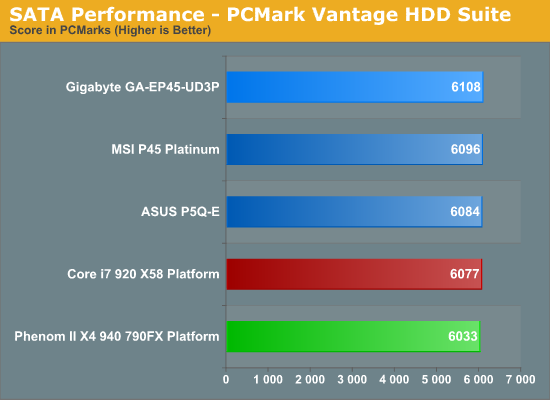
All of the P45 boards utilize the ICH10R for primary storage duties, so there is little difference between the results. ASUS normally finishes first in our storage tests but GIGABYTE was able to pull slightly ahead with the GA-EP45-UD3P.
USB / FireWire Performance
Our USB transfer speed tests are conducted with an OCZ Rally 2 Turbo 4GB Flash Drive and USB 2.0/FireWire based Maxtor OneTouch II external hard drive. In the small file test, we transfer a 602MB folder containing 444 files of various sizes from our hard drive to the USB Flash drive. In the large file test, we transfer a 1.90GB file folder containing 17 different files from our hard drive to the external drive utilizing the USB 2.0 and IEEE 1394a interface.
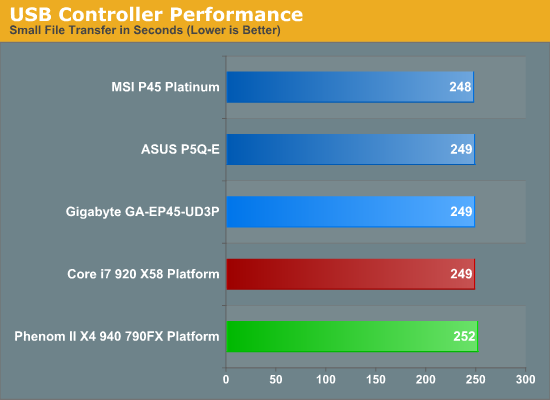
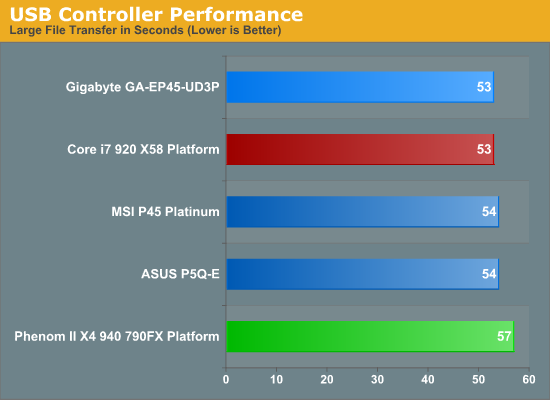
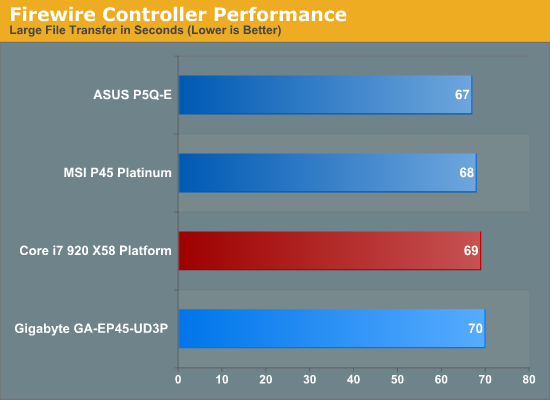
USB performance is a wash since all of the P45 boards use the same ICH10R chipset that provides the USB capabilities. While our synthetic HD Tune tests indicate parity between the boards, the actual transfer of files in the small file test indicates a slight advantage to MSI's implementation. Our large file USB test basically results in a tie as we are comparing the same chipset and the external hard drive becomes the limiting factor. The VIA and LSI FireWire solutions on the MSI and ASUS boards hold a small advantage over the Texas Instruments chipset on the GIGABYTE board.
Networking
The Windows 2000 Driver Development Kit (DDK) includes a useful LAN testing utility called NTttcp. We used the NTttcp tool to test Ethernet throughput and the CPU utilization of the various Ethernet Controllers used on the Intel motherboards. We set up one machine as the server; in this test, an Intel system with an Intel CSA Gigabit LAN connection. Intel CSA has a reputation for providing fast throughput and is a logical choice for our Gigabit LAN server.
On the server side, we used the following Command Line as suggested by the VIA whitepaper on LAN testing:
Ntttcpr -m 4,0,‹server IP› -a 4 -l 256000 -n 30000
On the client side (the motherboard under test), we used the following Command Line:
Ntttcps -m 4,0,‹client IP› -a 4 -l 256000 -n 30000
At the conclusion of the test, we captured the throughput and CPU utilization figures from the client screen.
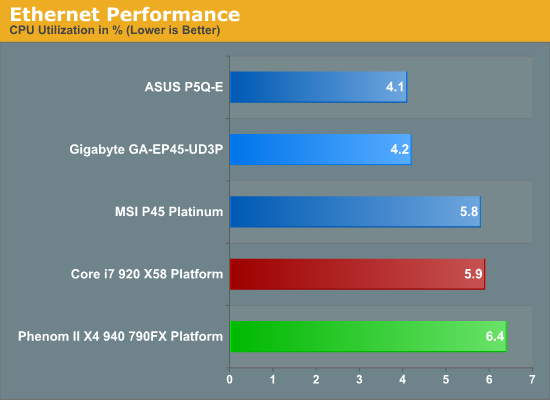
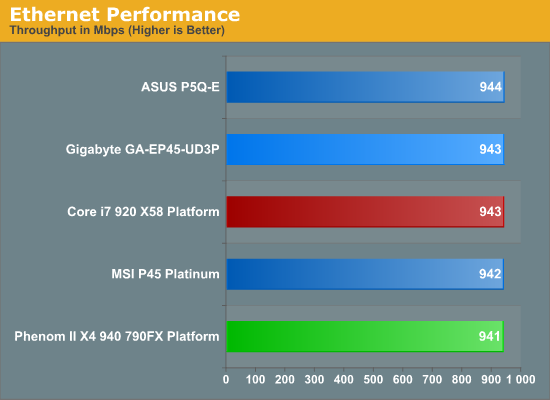
Our network throughput test indicates how well a particular controller design from Realtek, Marvell, or Intel performs instead of being indicative of true chipset performance. This also holds true for the CPU utilization results, though this test can also be influenced to certain degree by the BIOS code and chipset interconnect design.
The CPU utilization and throughput numbers favor the Marvell controller on the ASUS board, followed closely by the Realtek chipsets on the MSI and GIGABYTE boards. In practice, few if any users will notice a difference, even if they have the requisite gigabit hub, as storage performance frequently bottlenecks the actual transfer rates.










73 Comments
View All Comments
GhettoFly - Tuesday, February 3, 2009 - link
I'm guessing the 1250 kit you guys managed to clock at 1300 was Corsair's TWIN2X2048-10000C5DF. I have a set of those, but haven't tested with my UD3P yet; however I got my Geil DDR2-1160 C4 kit up to DDR2-1333 C5 on this board with only 2.48V using the 1333 OC profile: http://i4memory.com/f90/gigabyte-ep45-ud3p-memory-...">http://i4memory.com/f90/gigabyte-ep45-ud3p-memory-...This board is too much fun!
Gary Key - Wednesday, February 4, 2009 - link
Yes, it is the Corsair kit and it was an early review sample to boot. Corsair sent us a new SPD and I managed to hit 1333 this morning at 2.50V on it, so I can report that 1333 is stable on this board now after a few runs of Crysis and PCMark Vantage. :)GhettoFly - Wednesday, February 11, 2009 - link
It just seems a bit odd advertising DDR2-1366+ OC capabilities when the ICs needed for such clocks (D9GMH/GKX) are EOL :px86 64 - Sunday, February 15, 2009 - link
I'm still seeing some around and very cheap compared to what they used to be. You can pick up two 2x1GB (4GB) kits of PC2-10400 or PC2-9600 for under $275-$300 US.I think there are third party manufacturers who are still making the D9GMH\GKX, etc, because companies like Cellshock (now recently defunct) and Team Group (active) are still selling both of the most popular flavors of D9. Team is very big in Asia so it's not like they are some small niche company like Cellshock moving a small quantity of old stock. All of Team Group's Xtreem memory (not the "Dark" branding) is either GMH or GKX. How else to explain the constant flow of Micron D9 IC's to certain companies? Could there be that much stock still left over in Asia where they are selling them this long after they were discontinued?? I would be surprised.
GhettoFly - Sunday, February 15, 2009 - link
It has to be old stock of the ICs at least; when you look at the codes on the ICs themselves (not the D9Gxx code, but like 7KD22) I'm pretty sure the first number indicates the year of manufacture, 7 being 2007, 6 being 2006, etc. I haven't see any Micron RevD chips that have those codes staring with 8 even on sticks with a 2008 production date, for example my Geil 1160 C4 and Team Xtreem 9600 kits, the ICs on both have that code starting with a 7.Mr Roboto - Wednesday, February 18, 2009 - link
I don't know what the number is on the IC's themselves but you can check the manufacture date of your memory using a monitoring program like Everest.I have a set of Team's and using Everest they say the 14th week of 2008 as the date or manufacture.
Whether or not the IC's were made then or the modules themselves is debatable.
x86 64 - Sunday, February 15, 2009 - link
I think you might be right. I just pulled the spreaders off my Team 1200Mhz and sure enough it starts with a 7. I hope they don't run out anytime soon because it's so much fun to push this stuff :)It's weird, this has to be the first time in a long time that I'm happy with "last generation" hardware. I just don't see the benefit of i7 and DDR3 right now. I'm enjoying the rock solid P45, excellent inexpensive dual and quad Penryn's and dirt cheap high performance memory. I'd rather buy double the current hardware then spend the same amount for an entry level i7 system and get a 20% increase in performance. I'm sure the i7 will make a great server or HPC but I'm not impressed to much with the desktop parts. We need some multithreaded applications first. Software is seriously lagging.
I'll wait for the die shrink and in the mean time stick with my DDR2 and D9GKX\GMH :)
x86 64 - Sunday, February 15, 2009 - link
Also here's a picture of a TG kit from a review at XBit Labs from the summer of 2007 and it's marked with a 6 which would be in line with the markings on the recent chips, just one year back.http://www.xbitlabs.com/images/memory/team-xtreem/...">http://www.xbitlabs.com/images/memory/team-xtreem/...
GhettoFly - Wednesday, February 18, 2009 - link
Looks like I have to eat my words about no D9 being manufactured in 2008, these are powering the G.Skill 2GBHK sticks I got in today.http://www.xtremesystems.org/forums/showpost.php?p...">http://www.xtremesystems.org/forums/showpost.php?p...
Glenn - Tuesday, February 3, 2009 - link
Great article Gary! I have built approximately 10 systems so far with this board or it's single PCIe X16 twin UD3R, and the "C" version with the DDR3/DDR2 slots. My experiences with each are just as pleasing as you have reported. My own system is the C version with a Q9550 slightly overclocked to 3.4GHz. I am excited to see the followup on the Ultra Durable 3 technology.I am equally or even more excited that you are testing the support of Gigabyte and other manufacturers. I have built over 100 systems using gigabyte P35/G35 and now P45/G45 boards in the past year and a half and I honestly nearly quit using them over some issues with the G45 board when it was first released. It wasn't even close to stable but subsequent bios'es corrected all my complaints. I could get no response from Gigabyte during that time and was pretty pist off! Interestingly enough, I just about switched all my builds to Asus, but I was reminded of past problems with them on my first P45Q build when I went to download the newest drivers! Why does a multibillion dollar company like Asus insist on having a dog-assed slow website that is so painful to negotiate? At times during the day, one can't even get a page to open without timing out! And it's been that way for years! Gigabyte! You owe Asus a "save" on that one! Kudos to Anands crew for taking up these frustrations with the mfgs! Great article!